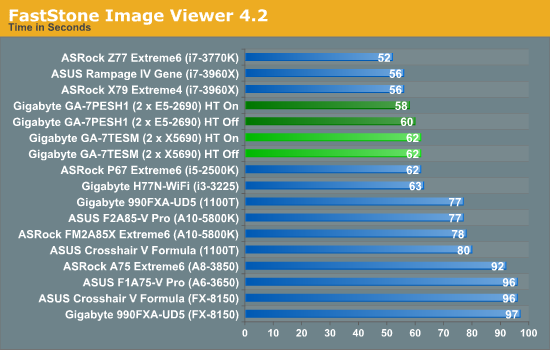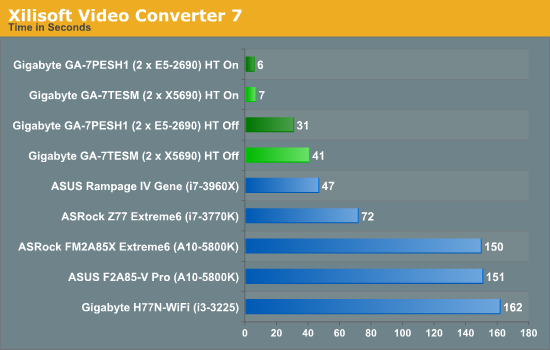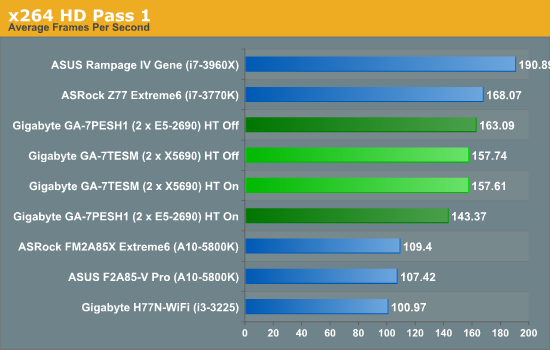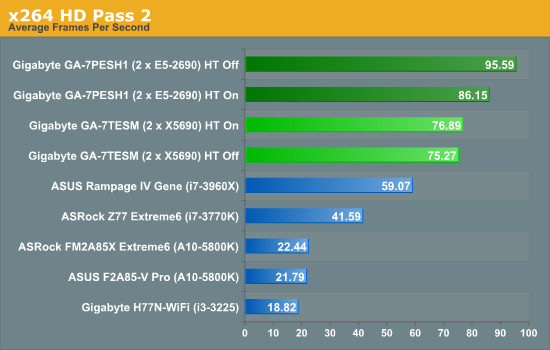Westmere-EP to Sandy Bridge-EP: The Scientist Potential Upgrade
by Ian Cutress on March 4, 2013 9:30 AM EST- Posted in
- CPUs
- Xeon
- Westmere-EP
- Sandy Bridge-EP
For completeness, we run our normal motherboard benchmarks.
WinRAR x64 3.93 - link
With 64-bit WinRAR, we compress the set of files used in the USB speed tests. WinRAR x64 3.93 attempts to use multithreading when possible, and provides as a good test for when a system has variable threaded load. If a system has multiple speeds to invoke at different loading, the switching between those speeds will determine how well the system will do.

Despite the slight memory difference between the two platforms, using E5-2690s with HT off has a significant 29% advantage over HT being on or the X5690 results.
FastStone Image Viewer 4.2 - link
FastStone Image Viewer is a free piece of software I have been using for quite a few years now. It allows quick viewing of flat images, as well as resizing, changing color depth, adding simple text or simple filters. It also has a bulk image conversion tool, which we use here. The software currently operates only in single-thread mode, which should change in later versions of the software. For this test, we convert a series of 170 files, of various resolutions, dimensions and types (of a total size of 163MB), all to the .gif format of 640x480 dimensions.

With the single thread speeds being similar, the only separation between our systems should be IPC – and thus as expected the Sandy Bridge-EP system is ahead, but only by 3-6%.
Xilisoft Video Converter
With XVC, users can convert any type of normal video to any compatible format for smartphones, tablets and other devices. By default, it uses all available threads on the system, and in the presence of appropriate graphics cards, can utilize CUDA for NVIDIA GPUs as well as AMD APP for AMD GPUs. For this test, we use a set of 32 HD videos, each lasting 30 seconds, and convert them from 1080p to an iPod H.264 video format using just the CPU. The time taken to convert these videos gives us our result.

With XVC having many threads is what counts, meaning that 24 threads on a full X5690 system will equal our small video conversion test. At this level, we would need more content to see significant difference. With HT off however, the Westmere-EP result is nearer that of a single 3960X than the E5-2690s.
x264 HD Benchmark
The x264 HD Benchmark uses a common HD encoding tool to process an HD MPEG2 source at 1280x720 at 3963 Kbps. This test represents a standardized result which can be compared across other reviews, and is dependant on both CPU power and memory speed. The benchmark performs a 2-pass encode, and the results shown are the average of each pass performed four times.












44 Comments
View All Comments
nadana23 - Sunday, March 10, 2013 - link
It's a pity you didn't read my reply to the previous article...http://www.anandtech.com/comments/6533/gigabyte-ga...
Your memory setup is the constraining factor here.
Add another 8pcs DIMM to your setup next time - you're bandwidth starving the E5-26xx memory controller!
IanCutress - Tuesday, March 12, 2013 - link
How so? Each channel on both processors is populated by one DIMM. Moving to two DIMMs per channel won't make a difference, they're still fed by the same channel.sking.tech - Tuesday, March 12, 2013 - link
The comments about people berating the Titan GPU - the titan is slower in overall performance than the GTX 690 yet they are at the same price point. That's kind of ridiculous. Why would someone pay more for less?ipheegrl - Thursday, May 23, 2013 - link
I would upgrade from Westmere-EP if it weren't for the fact that it was the last line of Xeons that could overclock. Granted, some people want guaranteed stability so overclocking isn't an option, but for budget users who want performance at the price of decreased stability it's a viable solution.